
A | B | C | D | E | F | G | H | CH | I | J | K | L | M | N | O | P | Q | R | S | T | U | V | W | X | Y | Z | 0 | 1 | 2 | 3 | 4 | 5 | 6 | 7 | 8 | 9
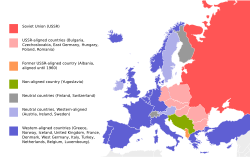
| Eastern Bloc |
|---|
 |
The Eastern Bloc, also known as the Communist Bloc (Combloc), the Socialist Bloc, and the Soviet Bloc, was the coalition of communist states of Central and Eastern Europe, Asia, Africa, and Latin America that were aligned with the Soviet Union and existed during the Cold War (1947–1991). These states followed the ideology of Marxism–Leninism, in opposition to the capitalist Western Bloc. The Eastern Bloc was often called the "Second World", whereas the term "First World" referred to the Western Bloc and "Third World" referred to the non-aligned countries that were mainly in Africa, Asia, and Latin America but notably also included former pre-1948 Soviet ally Yugoslavia, which was located in Europe.
In Western Europe, the term Eastern Bloc generally referred to the USSR and Central and Eastern European countries in the Comecon (East Germany, Poland, Czechoslovakia, Hungary, Romania, Bulgaria, and Albania[a]). In Asia, the Eastern Bloc comprised Mongolia, Vietnam, Laos, Kampuchea, North Korea, South Yemen, Syria and China.[b][c] In the Americas, the countries aligned with the Soviet Union included Cuba from 1961 and for limited periods Nicaragua and Grenada.[1]
Terminology
The term Eastern Bloc was often used interchangeably with the term Second World. This broadest usage of the term would include not only Maoist China and Cambodia, but also short-lived Soviet satellites such as the Second East Turkestan Republic (1944–1949), the People's Republic of Azerbaijan (1945–1946) and the Republic of Mahabad (1946), as well as the Marxist–Leninist states straddling the Second and Third Worlds before the end of the Cold War: the People's Democratic Republic of Yemen (from 1967), the People's Republic of the Congo (from 1969), the People's Republic of Benin, the People's Republic of Angola and People's Republic of Mozambique from 1975, the People's Revolutionary Government of Grenada from 1979 to 1983, the Derg/People's Democratic Republic of Ethiopia from 1974, and the Somali Democratic Republic from 1969 until the Ogaden War in 1977.[2][3][4][5] Although not Marxist–Leninist, leadership of Ba'athist Syria officially regarded the country as part of the Socialist Bloc and established a close economic, military alliance with the Soviet Union.[6][7]
Many states were accused by the Western Bloc of being in the Eastern Bloc when they were part of the Non-Aligned Movement. The most limited definition of the Eastern Bloc would only include the Warsaw Pact states and the Mongolian People's Republic as former satellite states most dominated by the Soviet Union. Cuba's defiance of complete Soviet control was noteworthy enough that Cuba was sometimes excluded as a satellite state altogether, as it sometimes intervened in other Third World countries even when the Soviet Union opposed this.[1]
Post-1991 usage of the term "Eastern Bloc" may be more limited in referring to the states forming the Warsaw Pact (1955–1991) and Mongolia (1924–1991), which are no longer communist states.[8][9] Sometimes they are more generally referred to as "the countries of Eastern Europe under communism",[10] excluding Mongolia, but including Yugoslavia and Albania which had both split with the Soviet Union by the 1960s.[11]
Even though Yugoslavia was a socialist country, it was not a member of the Comecon or the Warsaw Pact. Parting with the USSR in 1948, Yugoslavia did not belong to the East, but it also did not belong to the West because of its socialist system and its status as a founding member of the Non-Aligned Movement.[12] However, some sources consider Yugoslavia to be a member of the Eastern Bloc.[11][13][14][15][16][17][18][19] Others consider Yugoslavia not to be a member after it broke with Soviet policy in the 1948 Tito–Stalin split.[20][21][12]
List of states

Comecon (1949–1991) and Warsaw Pact (1955–1991)
 Albania (1946–1991, ceased participating in Comecon and Warsaw Pact activities in 1961, then officially withdrew in 1968 from the WP and in 1987 from Comecon)
Albania (1946–1991, ceased participating in Comecon and Warsaw Pact activities in 1961, then officially withdrew in 1968 from the WP and in 1987 from Comecon) Bulgaria (1946–1990)
Bulgaria (1946–1990) Cuba (from 1959)
Cuba (from 1959) Czechoslovakia (1948–1989)
Czechoslovakia (1948–1989) East Germany (1949–1989; previously as Soviet occupation zone of Germany, 1945–1949)
East Germany (1949–1989; previously as Soviet occupation zone of Germany, 1945–1949) Hungary (1949–1989)
Hungary (1949–1989) Mongolia (1924–1990)
Mongolia (1924–1990) Poland (1947–1989)
Poland (1947–1989) Romania (1947–1989, limited participation in Warsaw Pact activities after 1964)[d]
Romania (1947–1989, limited participation in Warsaw Pact activities after 1964)[d] Soviet Union (1922–1991; previously as the Russian SFSR, 1917–1922)
Soviet Union (1922–1991; previously as the Russian SFSR, 1917–1922)
 Byelorussian SSR (1919–1991, UN member state from 1945)
Byelorussian SSR (1919–1991, UN member state from 1945) Ukrainian SSR (1919–1991, UN member state from 1945)
Ukrainian SSR (1919–1991, UN member state from 1945)
 Vietnam (1976–1989, previously as North Vietnam 1945–1976 and Republic of South Vietnam 1975–1976)
Vietnam (1976–1989, previously as North Vietnam 1945–1976 and Republic of South Vietnam 1975–1976)
Other aligned states
 Afghanistan (1978–1991)
Afghanistan (1978–1991) Angola (1975–1991)
Angola (1975–1991) Benin (1975–1990)
Benin (1975–1990) China (1949–1961)[e]
China (1949–1961)[e] Congo (1969–1991)
Congo (1969–1991) Ethiopia (1987–1991, previously as Provisional Military Government of Socialist Ethiopia, 1974–1987)
Ethiopia (1987–1991, previously as Provisional Military Government of Socialist Ethiopia, 1974–1987) Grenada (1979–1983)
Grenada (1979–1983) Kampuchea (1979–1989)
Kampuchea (1979–1989) North Korea (1948–1990, previously as Soviet Civil Administration in Korea, 1945–1948)
North Korea (1948–1990, previously as Soviet Civil Administration in Korea, 1945–1948) Laos (1975–1989)
Laos (1975–1989) Mozambique (1975–1990)
Mozambique (1975–1990) Seychelles (1977-1991)
Seychelles (1977-1991) Somalia (1969–1991; severed alignment 1978)
Somalia (1969–1991; severed alignment 1978) South Yemen (1967–1990)
South Yemen (1967–1990) Syria (1963–1991)[22][6][7]
Syria (1963–1991)[22][6][7] Yugoslavia (1945–1948)[f]
Yugoslavia (1945–1948)[f]
Foundation history
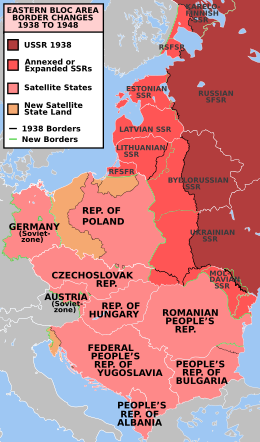
In 1922, the Russian SFSR, the Ukrainian SSR, the Byelorussian SSR and the Transcaucasian SFSR approved the Treaty of Creation of the USSR and the Declaration of the Creation of the USSR, forming the Soviet Union.[23] Soviet leader Joseph Stalin, who viewed the Soviet Union as a "socialist island", stated that the Soviet Union must see that "the present capitalist encirclement is replaced by a socialist encirclement".[24]
Expansion of the Soviet Union from 1939 to 1940
In 1939, the USSR entered into the Molotov–Ribbentrop Pact with Nazi Germany[25] that contained a secret protocol that divided Romania, Poland, Latvia, Lithuania, Estonia and Finland into German and Soviet spheres of influence.[25][26] Eastern Poland, Latvia, Estonia, Finland and Bessarabia in northern Romania were recognized as parts of the Soviet sphere of influence.[26] Lithuania was added in a second secret protocol in September 1939.[27]
The Soviet Union had invaded the portions of eastern Poland assigned to it by the Molotov–Ribbentrop Pact two weeks after the German invasion of western Poland, followed by co-ordination with German forces in Poland.[28][29] During the Occupation of East Poland by the Soviet Union, the Soviets liquidated the Polish state, and a German-Soviet meeting addressed the future structure of the "Polish region".[30] Soviet authorities immediately started a campaign of sovietization[31][32] of the newly Soviet-annexed areas.[33][34][35] Soviet authorities collectivized agriculture,[36] and nationalized and redistributed private and state-owned Polish property.[37][38][39]
Initial Soviet occupations of the Baltic countries had occurred in mid-June 1940, when Soviet NKVD troops raided border posts in Lithuania, Estonia and Latvia,[40][41] followed by the liquidation of state administrations and replacement by Soviet cadres.[40][42] Elections for parliament and other offices were held with single candidates listed and the official results fabricated, purporting pro-Soviet candidates' approval by 92.8 percent of the voters in Estonia, 97.6 percent in Latvia, and 99.2 percent in Lithuania.[43][44] The fraudulently installed "people's assemblies" immediately declared each of the three corresponding countries to be "Soviet Socialist Republics" and requested their "admission into Stalin's Soviet Union". This formally resulted in the Soviet Union's annexation of Lithuania, Latvia, and Estonia in August 1940.[43] The international community condemned this annexation of the three Baltic countries and deemed it illegal.[45][46]
In 1939, the Soviet Union unsuccessfully attempted an invasion of Finland,[47] subsequent to which the parties entered into an interim peace treaty granting the Soviet Union the eastern region of Karelia (10% of Finnish territory),[47] and the Karelo-Finnish Soviet Socialist Republic was established by merging the ceded territories with the KASSR. After a June 1940 Soviet Ultimatum demanding Bessarabia, Bukovina, and the Hertsa region from Romania,[48][49] the Soviets entered these areas, Romania caved to Soviet demands and the Soviets occupied the territories.[48][50]
Eastern Front and Allied conferences

In June 1941, Germany broke the Molotov-Ribbentrop pact by invading the Soviet Union. From the time of this invasion to 1944, the areas annexed by the Soviet Union were part of Germany's Ostland (except for the Moldavian SSR). Thereafter, the Soviet Union began to push German forces westward through a series of battles on the Eastern Front.
In the aftermath of World War II on the Soviet-Finnish border, the parties signed another peace treaty ceding to the Soviet Union in 1944, followed by a Soviet annexation of roughly the same eastern Finnish territories as those of the prior interim peace treaty as part of the Karelo-Finnish Soviet Socialist Republic.[51]
From 1943 to 1945, several conferences regarding Post-War Europe occurred that, in part, addressed the potential Soviet annexation and control of countries in Central Europe. There were various Allied plans for state order in Central Europe for post-war. While Joseph Stalin tried to get as many states under Soviet control as possible, British Prime Minister Winston Churchill preferred a Central European Danube Confederation to counter these countries against Germany and Russia.[52] Churchill's Soviet policy regarding Central Europe differed vastly from that of American President Franklin D. Roosevelt, with the former believing Soviet leader Stalin to be a "devil"-like tyrant leading a vile system.[53]
When warned of potential domination by a Stalin dictatorship over part of Europe, Roosevelt responded with a statement summarizing his rationale for relations with Stalin: "I just have a hunch that Stalin is not that kind of a man. ... I think that if I give him everything I possibly can and ask for nothing from him in return, noblesse oblige, he won't try to annex anything and will work with me for a world of democracy and peace".[54] While meeting with Stalin and Roosevelt in Tehran in 1943, Churchill stated that Britain was vitally interested in restoring Poland as an independent country.[55] Britain did not press the matter for fear that it would become a source of inter-allied friction.[55]
In February 1945, at the conference at Yalta, Stalin demanded a Soviet sphere of political influence in Central Europe.[56] Stalin eventually was convinced by Churchill and Roosevelt not to dismember Germany.[56] Stalin stated that the Soviet Union would keep the territory of eastern Poland they had already taken via invasion in 1939, and wanted a pro-Soviet Polish government in power in what would remain of Poland.[56] After resistance by Churchill and Roosevelt, Stalin promised a re-organization of the current pro-Soviet government on a broader democratic basis in Poland.[56] He stated that the new government's primary task would be to prepare elections.[57]
The parties at Yalta further agreed that the countries of liberated Europe and former Axis satellites would be allowed to "create democratic institutions of their own choice", pursuant to "the right of all peoples to choose the form of government under which they will live".[58] The parties also agreed to help those countries form interim governments "pledged to the earliest possible establishment through free elections" and "facilitate where necessary the holding of such elections".[58]
At the beginning of the July–August 1945 Potsdam Conference after Germany's unconditional surrender, Stalin repeated previous promises to Churchill that he would refrain from a "sovietization" of Central Europe.[59] In addition to reparations, Stalin pushed for "war booty", which would permit the Soviet Union to directly seize property from conquered nations without quantitative or qualitative limitation.[60] A clause was added permitting this to occur with some limitations.[60]
Concealed transformation dynamics
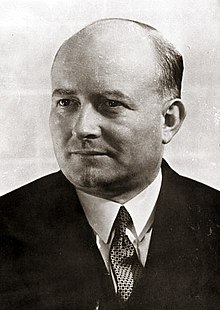
At first, the Soviets concealed their role in other Eastern Bloc politics, with the transformation appearing as a modification of Western "bourgeois democracy".[61] As a young communist was told in East Germany, "it's got to look democratic, but we must have everything in our control".[62] Stalin felt that socioeconomic transformation was indispensable to establish Soviet control, reflecting the Marxist–Leninist view that material bases, the distribution of the means of production, shaped social and political relations.[63] The Soviet Union also co-opted the Eastern European countries into its sphere of influence by making reference to some cultural commonalities.[64]
Moscow-trained cadres were put into crucial power positions to fulfill orders regarding sociopolitical transformation.[63] Elimination of the bourgeoisie's social and financial power by expropriation of landed and industrial property was accorded absolute priority.[61] These measures were publicly billed as "reforms" rather than socioeconomic transformations.[61] Except for initially in Czechoslovakia, activities by political parties had to adhere to "Bloc politics", with parties eventually having to accept membership in an "antifascist bloc" obliging them to act only by mutual "consensus".[65] The bloc system permitted the Soviet Union to exercise domestic control indirectly.[66]
Crucial departments such as those responsible for personnel, general police, secret police and youth were strictly Communist run.[66] Moscow cadres distinguished "progressive forces" from "reactionary elements" and rendered both powerless. Such procedures were repeated until Communists had gained unlimited power and only politicians who were unconditionally supportive of Soviet policy remained.[67]
Early events prompting stricter control
Marshall Plan rejection

In June 1947, after the Soviets had refused to negotiate a potential lightening of restrictions on German development, the United States announced the Marshall Plan, a comprehensive program of American assistance to all European countries wanting to participate, including the Soviet Union and those of Eastern Europe.[68] The Soviets rejected the Plan and took a hard-line position against the United States and non-communist European nations.[69] However, Czechoslovakia was eager to accept the US aid; the Polish government had a similar attitude, and this was of great concern to the Soviets.[70]
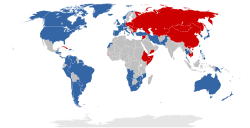
In one of the clearest signs of Soviet control over the region up to that point, the Czechoslovakian foreign minister, Jan Masaryk, was summoned to Moscow and berated by Stalin for considering joining the Marshall Plan. Polish Prime minister Józef Cyrankiewicz was rewarded for the Polish rejection of the Plan with a huge 5-year trade agreement, including $450 million in credit, 200,000 tons of grain, heavy machinery and factories.[71]
In July 1947, Stalin ordered these countries to pull out of the Paris Conference on the European Recovery Programme, which has been described as "the moment of truth" in the post-World War II division of Europe.[72] Thereafter, Stalin sought stronger control over other Eastern Bloc countries, abandoning the prior appearance of democratic institutions.[73] When it appeared that, in spite of heavy pressure, non-communist parties might receive in excess of 40% of the vote in the August 1947 Hungarian elections, repressions were instituted to liquidate any independent political forces.[73]
In that same month, annihilation of the opposition in Bulgaria began on the basis of continuing instructions by Soviet cadres.[73][74] At a late September 1947 meeting of all communist parties in Szklarska Poręba,[75] Eastern Bloc communist parties were blamed for permitting even minor influence by non-communists in their respective countries during the run up to the Marshall Plan.[73]
Berlin blockade and airlift
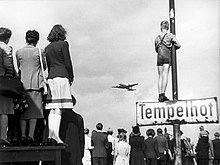
In the former German capital Berlin, surrounded by Soviet-occupied Germany, Stalin instituted the Berlin Blockade on 24 June 1948, preventing food, materials and supplies from arriving in West Berlin.[76] The blockade was caused, in part, by early local elections of October 1946 in which the Socialist Unity Party of Germany (SED) was rejected in favor of the Social Democratic Party, which had gained two and a half times more votes than the SED.[77] The United States, Britain, France, Canada, Australia, New Zealand and several other countries began a massive "Berlin airlift", supplying West Berlin with food and other supplies.[78]
The Soviets mounted a public relations campaign against the western policy change and communists attempted to disrupt the elections of 1948 preceding large losses therein,[79] while 300,000 Berliners demonstrated and urged the international airlift to continue.[80] In May 1949, Stalin lifted the blockade, permitting the resumption of Western shipments to Berlin.[81][82]
Tito–Stalin split
After disagreements between Yugoslav leader Josip Broz Tito and the Soviet Union regarding Greece and Albania, a Tito–Stalin split occurred, followed by Yugoslavia being expelled from the Cominform in June 1948 and a brief failed Soviet putsch in Belgrade.[83] The split created two separate communist forces in Europe.[83] A vehement campaign against Titoism was immediately started in the Eastern Bloc, describing agents of both the West and Tito in all places as engaging in subversive activity.[83]
Stalin ordered the conversion of the Cominform into an instrument to monitor and control the internal affairs of other Eastern Bloc parties.[83] He also briefly considered converting the Cominform into an instrument for sentencing high-ranking deviators, but dropped the idea as impractical.[83] Instead, a move to weaken communist party leaders through conflict was started.[83] Soviet cadres in communist party and state positions in the Bloc were instructed to foster intra-leadership conflict and to transmit information against each other.[83] This accompanied a continuous stream of accusations of "nationalistic deviations", "insufficient appreciation of the USSR's role", links with Tito and "espionage for Yugoslavia".[84] This resulted in the persecution of many major party cadres, including those in East Germany.[84]
The first country to experience this approach was Albania, where leader Enver Hoxha immediately changed course from favoring Yugoslavia to opposing it.[84] In Poland, leader Władysław Gomułka, who had previously made pro-Yugoslav statements, was deposed as party secretary-general in early September 1948 and subsequently jailed.[84] In Bulgaria, when it appeared that Traicho Kostov, who was not a Moscow cadre, was next in line for leadership, in June 1949, Stalin ordered Kostov's arrest, followed soon thereafter by a death sentence and execution.[84] A number of other high ranking Bulgarian officials were also jailed.[84] Stalin and Hungarian leader Mátyás Rákosi met in Moscow to orchestrate a show trial of Rákosi opponent László Rajk, who was thereafter executed.[85] The preservation of the Soviet bloc relied on maintaining a sense of ideological unity that would entrench Moscow's influence in Eastern Europe as well as the power of the local Communist elites.[86]
The port city of Trieste was a particular focus after the Second World War. Until the break between Tito and Stalin, the Western powers and the Eastern bloc faced each other uncompromisingly. The neutral buffer state Free Territory of Trieste, founded in 1947 with the United Nations, was split up and dissolved in 1954 and 1975, also because of the détente between the West and Tito.[87][88]
Politics

Despite the initial institutional design of communism implemented by Joseph Stalin in the Eastern Bloc, subsequent development varied across countries.[89] In satellite states, after peace treaties were initially concluded, opposition was essentially liquidated, fundamental steps towards socialism were enforced, and Kremlin leaders sought to strengthen control therein.[90] Right from the beginning, Stalin directed systems that rejected Western institutional characteristics of market economies, capitalist parliamentary democracy (dubbed "bourgeois democracy" in Soviet parlance) and the rule of law subduing discretional intervention by the state.[91] The resulting states aspired to total control of a political center backed by an extensive and active repressive apparatus, and a central role of Marxist–Leninist ideology.[91]
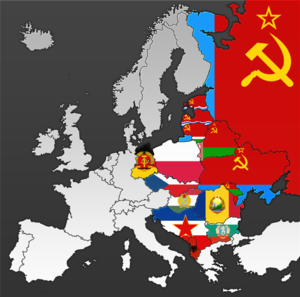
However, the vestiges of democratic institutions were never entirely destroyed, resulting in the façade of Western style institutions such as parliaments, which effectively just rubber-stamped decisions made by rulers, and constitutions, to which adherence by authorities was limited or non-existent.[91] Parliaments were still elected, but their meetings occurred only a few days per year, only to legitimize politburo decisions, and so little attention was paid to them that some of those serving were actually dead, and officials would openly state that they would seat members who had lost elections.[92]
The first or General Secretary of the central committee in each communist party was the most powerful figure in each regime.[93] The party over which the politburo held sway was not a mass party but, conforming with Leninist tradition, a smaller selective party of between three and fourteen percent of the country's population who had accepted total obedience.[94] Those who secured membership in this selective group received considerable rewards, such as access to special lower priced shops with a greater selection of high-quality domestic and/or foreign goods (confections, alcohol, cigars, cameras, televisions, and the like), special schools, holiday facilities, homes, high-quality domestic and/or foreign-made furniture, works of art, pensions, permission to travel abroad, and official cars with distinct license plates so that police and others could identify these members from a distance.[94]
Political and civil restrictions
In addition to emigration restrictions, civil society, defined as a domain of political action outside the party's state control, was not allowed to firmly take root, with the possible exception of Poland in the 1980s.[95] While the institutional design on the communist systems were based on the rejection of rule of law, the legal infrastructure was not immune to change reflecting decaying ideology and the substitution of autonomous law.[95] Initially, communist parties were small in all countries except Czechoslovakia, such that there existed an acute shortage of politically "trustworthy" persons for administration, police, and other professions.[96] Thus, "politically unreliable" non-communists initially had to fill such roles.[96] Those not obedient to communist authorities were ousted, while Moscow cadres started a large-scale party programs to train personnel who would meet political requirements.[96] Former members of the middle-class were officially discriminated against, though the state's need for their skills and certain opportunities to re-invent themselves as good Communist citizens did allow many to nonetheless achieve success.[97]
Communist regimes in the Eastern Bloc viewed marginal groups of opposition intellectuals as a potential threat because of the bases underlying Communist power therein.[98] The suppression of dissidence and opposition was considered a central prerequisite to retain power, though the enormous expense at which the population in certain countries were kept under secret surveillance may not have been rational.[98] Following a totalitarian initial phase, a post-totalitarian period followed the death of Stalin in which the primary method of Communist rule shifted from mass terror to selective repression, along with ideological and sociopolitical strategies of legitimation and the securing of loyalty.[99] Juries were replaced by a tribunal of a professional judges and two lay assessors that were dependable party actors.[100]
The police deterred and contained opposition to party directives.[100] The political police served as the core of the system, with their names becoming synonymous with raw power and the threat of violent retribution should an individual become active against the State.[100] Several state police and secret police organizations enforced communist party rule, including the following:
- East Germany – Stasi, Volkspolizei and KdA
- Soviet Union – KGB
- Czechoslovakia – STB and LM
- Bulgaria – KDS
- Albania – Sigurimi
- Hungary – ÁVH and Munkásőrség
- Romania – Securitate and GP
- Poland – Urząd Bezpieczeństwa, Służba Bezpieczeństwa and ZOMO
Media and information restrictions

The press in the communist period was an organ of the state, completely reliant on and subservient to the communist party.[101] Before the late 1980s, Eastern Bloc radio and television organizations were state-owned, while print media was usually owned by political organizations, mostly by the local communist party.[102] Youth newspapers and magazines were owned by youth organizations affiliated with communist parties.[102]
The control of the media was exercised directly by the communist party itself, and by state censorship, which was also controlled by the party.[102] Media served as an important form of control over information and society.[103] The dissemination and portrayal of knowledge were considered by authorities to be vital to communism's survival by stifling alternative concepts and critiques.[103] Several state Communist Party newspapers were published, including:
- Central newspapers of the Soviet Union
- Trybuna Ludu (Poland)
- Czerwony Sztandar (Vilnius) (1953–1990), Polish-language newspaper in Lithuanian SSR
- Népszabadság (until 1956 Szabad Nép, Hungary)
- Neues Deutschland (East Germany)
- Rabotnichesko Delo (Bulgaria)
- Rudé právo (Czechoslovakia)
- Rahva Hääl (annexed former Estonia)
- Pravda (Slovakia)
- Kauno diena (annexed former Lithuania)
- Scînteia (Romania)
- Zvyazda (Belarus).
The Telegraph Agency of the Soviet Union (TASS) served as the central agency for collection and distribution of internal and international news for all Soviet newspapers, radio and television stations. It was frequently infiltrated by Soviet intelligence and security agencies, such as the NKVD and GRU. TASS had affiliates in 14 Soviet republics, including the Lithuanian SSR, Latvian SSR, Estonian SSR, Moldavian SSR. Ukrainian SSR and Byelorussian SSR.
Western countries invested heavily in powerful transmitters which enabled services such as the BBC, VOA and Radio Free Europe (RFE) to be heard in the Eastern Bloc, despite attempts by authorities to jam the airways.
Religion

Under the state atheism of many Eastern Bloc nations, religion was actively suppressed.[104] Since some of these states tied their ethnic heritage to their national churches, both the peoples and their churches were targeted by the Soviets.[105][106]
Organizations
In 1949, the Soviet Union, Bulgaria, Czechoslovakia, Hungary, Poland, and Romania founded the Comecon in accordance with Stalin's desire to enforce Soviet domination of the lesser states of Central Europe and to mollify some states that had expressed interest in the Marshall Plan,[107][108] and which were now, increasingly, cut off from their traditional markets and suppliers in Western Europe.[72] The Comecon's role became ambiguous because Stalin preferred more direct links with other party chiefs than the Comecon's indirect sophistication; it played no significant role in the 1950s in economic planning.[109] Initially, the Comecon served as cover for the Soviet taking of materials and equipment from the rest of the Eastern Bloc, but the balance changed when the Soviets became net subsidizers of the rest of the Bloc by the 1970s via an exchange of low cost raw materials in return for shoddily manufactured finished goods.[110]
In 1955, the Warsaw Pact was formed partly in response to NATO's inclusion of West Germany and partly because the Soviets needed an excuse to retain Red Army units in Hungary.[108] For 35 years, the Pact perpetuated the Stalinist concept of Soviet national security based on imperial expansion and control over satellite regimes in Eastern Europe.[111] This Soviet formalization of their security relationships in the Eastern Bloc reflected Moscow's basic security policy principle that continued presence in East Central Europe was a foundation of its defense against the West.[111] Through its institutional structures, the Pact also compensated in part for the absence of Joseph Stalin's personal leadership since his death in 1953.[111] The Pact consolidated the other Bloc members' armies in which Soviet officers and security agents served under a unified Soviet command structure.[112]
Beginning in 1964, Romania took a more independent course.[113] While it did not repudiate either Comecon or the Warsaw Pact, it ceased to play a significant role in either.[113] Nicolae Ceaușescu's assumption of leadership one year later pushed Romania even further in the direction of separateness.[113] Albania, which had become increasingly isolated under Stalinist leader Enver Hoxha following de-Stalinization, undergoing an Albanian–Soviet split in 1961, withdrew from the Warsaw Pact in 1968[114] following the Warsaw Pact invasion of Czechoslovakia.[115]
Emigration restrictions and defectors
In 1917, Russia restricted emigration by instituting passport controls and forbidding the exit of belligerent nationals.[116] In 1922, after the Treaty on the Creation of the USSR, both the Ukrainian SSR and the Russian SFSR issued general rules for travel that foreclosed virtually all departures, making legal emigration impossible.[117] Border controls thereafter strengthened such that, by 1928, even illegal departure was effectively impossible.[117] This later included internal passport controls, which when combined with individual city Propiska ("place of residence") permits, and internal freedom of movement restrictions often called the 101st kilometre, greatly restricted mobility within even small areas of the Soviet Union.[118]

After the creation of the Eastern Bloc, emigration out of the newly occupied countries, except under limited circumstances, was effectively halted in the early 1950s, with the Soviet approach to controlling national movement emulated by most of the rest of the Eastern Bloc.[119] However, in East Germany, taking advantage of the Inner German border between occupied zones, hundreds of thousands fled to West Germany, with figures totaling 197,000 in 1950, 165,000 in 1951, 182,000 in 1952 and 331,000 in 1953.[120][121] One reason for the sharp 1953 increase was fear of potential further Sovietization with the increasingly paranoid[dubious ] actions of Joseph Stalin in late 1952 and early 1953.[122] 226,000 had fled in just the first six months of 1953.[123]
With the closing of the Inner German border officially in 1952,[124] the Berlin city sector borders remained considerably more accessible than the rest of the border because of their administration by all four occupying powers.[125] Accordingly, it effectively comprised a "loophole" through which Eastern Bloc citizens could still move west.[124] The 3.5 million East Germans that had left by 1961, called Republikflucht, totaled approximately 20% of the entire East German population.[126] In August 1961, East Germany erected a barbed-wire barrier that would eventually be expanded through construction into the Berlin Wall, effectively closing the loophole.[127]
With virtually non-existent conventional emigration, more than 75% of those emigrating from Eastern Bloc countries between 1950 and 1990 did so under bilateral agreements for "ethnic migration".[128] About 10% were refugee migrants under the Geneva Convention of 1951.[128] Most Soviets allowed to leave during this time period were ethnic Jews permitted to emigrate to Israel after a series of embarrassing defections in 1970 caused the Soviets to open very limited ethnic emigrations.[129] The fall of the Iron Curtain was accompanied by a massive rise in European East-West migration.[128] Famous Eastern Bloc defectors included Joseph Stalin's daughter Svetlana Alliluyeva, who denounced Stalin after her 1967 defection.[130]
Population
Eastern Bloc countries such as the Soviet Union had high rates of population growth. In 1917, the population of Russia in its present borders was 91 million. Despite the destruction in the Russian Civil War, the population grew to 92.7 million in 1926. In 1939, the population increased by 17 percent to 108 million. Despite more than 20 million deaths suffered throughout World War II, Russia's population grew to 117.2 million in 1959. The Soviet census of 1989 showed Russia's population at 147 million people.[131]
The Soviet economical and political system produced further consequences such as, for example, in Baltic states, where the population was approximately half of what it should have been compared with similar countries such as Denmark, Finland and Norway over the years 1939–1990. Poor housing was one factor leading to severely declining birth rates throughout the Eastern Bloc.[132] However, birth rates were still higher than in Western European countries. A reliance upon abortion, in part because periodic shortages of birth control pills and intrauterine devices made these systems unreliable,[133] also depressed the birth rate and forced a shift to pro-natalist policies by the late 1960s, including severe checks on abortion and propagandist exhortations like the 'heroine mother' distinction bestowed on those Romanian women who bore ten or more children.[134]
In October 1966, artificial birth control was proscribed in Romania and regular pregnancy tests were mandated for women of child-bearing age, with severe penalties for anyone who was found to have terminated a pregnancy.[135] Despite such restrictions, birth rates continued to lag, in part because of unskilled induced abortions.[134] The populations of the Eastern Bloc countries were as follows:[136][137]
| Country | Area (000s) | 1950 (mil) | 1970 (mil) | 1980 (mil) | 1985 (mil) | Annual growth (1950–1985) | Density (1980) |
|---|---|---|---|---|---|---|---|
| Albania | 28.7 square kilometres (11.1 sq mi) | 1.22 | 2.16 | 2.59 | 2.96 | +4.07% | 90.2/km2 |
| Bulgaria | 110.9 square kilometres (42.8 sq mi) | 7.27 | 8.49 | 8.88 | 8.97 | +0.67% | 80.1/km2 |
| Czechoslovakia | 127.9 square kilometres (49.4 sq mi) | 13.09 | 14.47 | 15.28 | 15.50 | Zdroj:https://en.wikipedia.org?pojem=Eastern_Bloc
